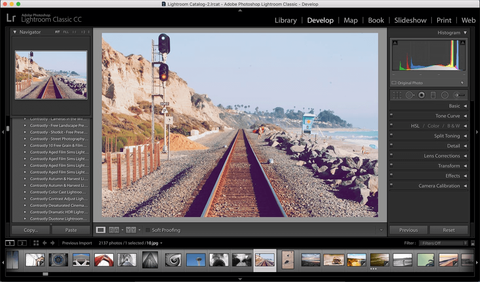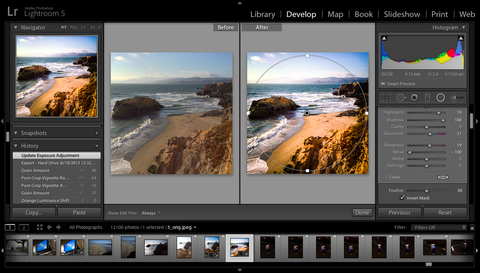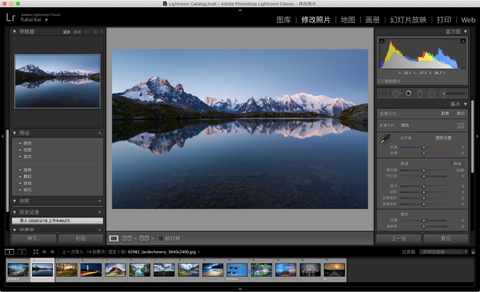Lightroom vs. Lightroom Classic: Which Is Right for You?
Lightroom and Lightroom Classic are two distinct versions of Adobe's photo editing software, each catering to different user needs.
Lightroom Classic employs a file-based cataloging system and is primarily a desktop application, offering precise editing tools and organization capabilities.
On the other hand, Lightroom, formerly known as Lightroom CC, operates on a cloud-based platform, emphasizing simplicity in sharing and automatic syncing of edits and organization across multiple devices.
This duality caters to varying workflows, with Lightroom Classic suited for traditional desktop-focused editing, while Lightroom offers convenience and mobility through its cloud-based features.
So, let's dive into the difference between Lightroom vs. Lightroom Classic!
What is Adobe Lightroom Classic?

Since its inception in 2007, Lightroom Classic has remained the go-to software for photographers, offering a comprehensive suite of tools for image organization and editing. Designed as a desktop application, it efficiently manages image files while providing a familiar user experience.
Photographers rely on Lightroom Classic for its robust features, enabling them to effortlessly organize, process, and print their extensive photo collections. From importing to exporting, the software's distinct modules cater to every aspect of the workflow, including organizing, developing, and printing.
While the editing and organizing modules are the primary focus, Lightroom Classic also offers additional functionalities such as map integration, book creation, slideshow generation, and web gallery development, though these features are less frequently utilized.
Moreover, Lightroom Classic seamlessly integrates with Creator Cloud subscriptions, allowing users to synchronize their photos across devices, despite its desktop-based nature. This blend of versatility and functionality has solidified Lightroom Classic's position as a cornerstone tool in the photography industry.
You can level up your photographs with our Artistic Photoshop Brushes Mega Bundle!
Pros of Lightroom Classic
Using the Lightroom Classic desktop version offers a comprehensive and comfortable experience. Its integration of keyboard shortcuts facilitates seamless navigation between modules and the application of preferred settings. Additionally, users can easily create, download, purchase, and export presets to enhance their workflow.
The advantage of expanding storage without monthly fees is notable, as images are stored locally on the computer or external hard drive. Creating shortcuts further accelerates the workflow within Lightroom Classic.
Beyond basic editing features, the software encompasses a range of functionalities including printing, slideshow creation, watermarking, and exporting. Its compatibility with multiple programs allows for seamless transitions between Lightroom and Photoshop Lightroom for further edits.
Cons of Lightroom Classic
Lightroom Classic boasts minimal drawbacks. However, users may encounter a learning curve and lose flexibility by being tied to a single device. Despite these limitations, its robust features for photo editing and organization make it a preferred choice for many photographers seeking powerful editing capabilities.
What is Adobe Lightroom CC?

Lightroom, originally branded as Lightroom CC under the Adobe Creative Cloud umbrella, serves as a vital asset for photographers seeking seamless integration across multiple platforms.
This software, tailored with potent editing and organizing functionalities, facilitates an online presence for photos while offering accessibility across various devices. Its default storage on the Cloud, rather than traditional local drives, enables ubiquitous access to one's photographic portfolio from any device equipped with a robust internet connection.
This feature proves invaluable for photographers constantly on the move, enabling them to swiftly edit and manage their images directly from mobile phones or tablets.
Whether on a distant shoot or simply on the go, Lightroom's cloud-based architecture ensures that photographers can effortlessly engage with their work, fostering creativity and productivity regardless of geographical constraints.
Thus, Adobe Creative Cloud Photography emerges as an indispensable tool for modern-day photographers seeking flexibility and efficiency in their workflow. You can take a step further with our Vintage Photoshop Actions Bundle.
Pros of Lightroom CC
Lightroom CC offers an intuitive interface, ideal for beginners. With preset application and customization options, users can adjust brightness, contrast, white balance, and vibrance effortlessly. Advanced features include noise reduction and color grading.
Original files are securely stored in the cloud as DNG raw files and JPEGs, accessible across devices via Adobe credentials, mitigating the risk of data loss from device failure. Automatic file backup ensures peace of mind.
Moreover, the software simplifies high-resolution image downloads, directs social media exports, and provides a plethora of additional functionalities. Lightroom CC is a comprehensive solution for professional photographers seeking efficiency, accessibility, and powerful editing capabilities.
Cons of Lightroom CC
In Lightroom CC, a streamlined version of Lightroom Classic, features are simplified for intuitive navigation but lack the depth of its counterpart. Adjustment precision is reduced compared to manual input.
Import/export options are limited to JPEG, DNG, TIF, or original formats, restricting flexibility. Cloud-based storage poses storage constraints, potentially leading to subscription cost escalation. This simplicity aids beginners but may frustrate advanced users seeking nuanced edits.
Despite these limitations, Lightroom CC's user-friendly interface and cloud integration offer convenience for photographers prioritizing accessibility over advanced editing capabilities. Balancing simplicity with functionality, it serves as an entry point to Adobe's photography ecosystem.
Difference: Lightroom vs. Lightroom Classic!

Now let's explore Lightroom vs. Lightroom Classic!
Signing up for Adobe Photography Plan will provide you access to both Lightroom Classic and Lightroom. Both apps help in photo editing and organizing, but still, they are different from each other.
Let's get started!
File Storage
Lightroom Classic and Lightroom CC differ significantly in terms of where they store images and image information. Lightroom Classic stores everything locally, requiring you to have your storage device with you to work on images.
While you manage folders within Lightroom, changing file locations externally can disrupt the organization. This setup suits desktop or laptop editing but poses challenges for on-the-go users needing multi-device access.
Alternatively, Lightroom CC stores data in the cloud, offering constant access to high-quality images without downloading large files. This cloud-based storage ensures automatic backups by Adobe, unlike Lightroom Classic, where users must manage backups independently.
Although Lightroom CC simplifies access and editing across devices, it primarily offers Smart Previews for on-the-go editing and sharing, requiring original files for extensive printing.
Understanding these differences enables users to choose the best option based on their workflow preferences and requirements.
To learn more, you can also check our YouTube tutorials.
Interface

Lightroom Classic boasts a robust toolset, organized into various modules, with Library and Develop being popular choices. Yet, it offers versatility beyond basic editing, including web galleries, photo books, slideshows, and geotagging.
However, mastering its full potential demands dedication due to its steep learning curve, requiring beginners to seek tutorials. Conversely, Lightroom CC provides a more user-friendly experience with its intuitive interface and Learn and Discovery section.
Upon launch, it showcases community photos for inspiration, offering editing insights and preset saving. Accessing files is straightforward via the All Photos panel, with organizing and adjustment tools readily available.
Lightroom CC's simplicity and social features cater to a modern, community-driven workflow.
Editing
Initially, Lightroom CC offered fewer features compared to its Classic counterpart. However, recent updates have significantly narrowed the gap in editing capabilities.
Since the February 2019 update, CC has gained essential tools like HSL panels, split toning, and tone curves, along with Panorama and HDR functionalities. Although some adjustments debut on Classic first, CC catches up gradually.
The April 2023 update marked a significant milestone with both versions receiving AI-powered Denoise and Facial Hair masking in People Masks. Smart Previews support in both versions facilitates space-saving on local or cloud storage, enhancing efficiency for users.
Importing and Exporting
When comparing Lightroom CC and Lightroom Classic, the discrepancy in importing and exporting functionality is evident.
Lightroom Classic offers extensive options during import, including saving to external drives, applying presets, and excluding specific images or folders. Its export capabilities encompass various parameters like file type and resolution.
Contrastingly, Lightroom CC lacks import flexibility; presets and keywords can't be applied during import. Initially limited in export choices, CC now offers more options but still falls short compared to Classic.
Moreover, CC lacks print options but excels in automatic phone-to-cloud uploads, benefiting mobile photographers but not traditional users. Nonetheless, CC facilitates efficient photo management with search, filter, and tagging features.
Image Organization and Search

Lightroom CC and Lightroom Classic offer formidable image search and organization abilities, but they diverge in significant ways. Lightroom CC leverages AI (Adobe Sensei) for object identification and boasts an efficient face recognition system, a boon for group photographers.
It supports searches by camera model, keyword, and location. Conversely, Lightroom Classic lacks AI keywording but offers advanced filtering options like lens, focal length, F-stop, and ISO searches.
Notably, Lightroom Classic's Smart Collections are absent in Lightroom CC, crucial for some photographers' organizational needs. However, both versions allow image syncing across devices via Lightroom Web and mobile platforms, offering flexibility in workflow management.
Summary: Lightroom vs. Lightroom Classic!
Let’s conclude “Lightroom vs. Lightroom Classic”! In the realm of photo editing software, Lightroom CC stands out as a versatile tool for on-the-go editing, catering to photographers seeking flexibility. On the other hand, Lightroom Classic remains the top choice for seasoned professionals due to its robust features and familiarity.
The beauty lies in flexibility; photographers need not feel constrained to pick one over the other. Adobe's Photography Plans offer the luxury of utilizing both, a trend embraced by many in 2024.
This dual approach allows for leveraging the strengths of each platform, catering to diverse editing needs and preferences within the photography community.
You can also explore a variety of high-quality Photoshop editing bundles and templates at Artixty store!

Leave a comment